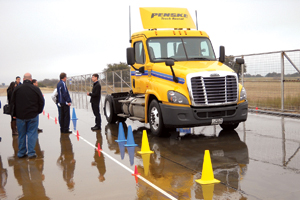Goodyear Rolling Out New Fuel Max Line; Says Tires Provide Fleets Additional Savings

This story appears in the March 16 print edition of Transport Topics.
SAN ANGELO, Texas — The Goodyear Tire & Rubber Co. is out to prove its engineering research and product development efforts can lead to financial savings for fleet customers.
Sales and marketing managers for the company’s commercial tire systems division demonstrated the performance of the Fuel Max line of tires that the company is introducing this year. The four head-to-head tests against tires made by competitors measured fuel economy, wet-pavement braking, puncture resistance and coasting ability.
To the eye, the tires are still round and black, but Brian Buckham, a company general manager, said the underlying technology is new and advanced, especially improvements in four types of rubber compounds.
“There’s the cap, the subtread, the cushion and the shoulder, and it takes a lot of technology to bring all four of those together,” Buckham said.
The Akron, Ohio-based manufacturer ran the tests for fleet executives and reporters March 4 at its 7,250-acre proving grounds here.
The three most critical demands on tires are fuel economy, durability and traction, Buckham said, adding that the challenge for tire engineers is to avoid demolishing one of those three pillars for the benefit of the other two.
For the fuel-economy test, Goodyear drove two loaded, 80,000-pound rigs, identical except for tires, on a 120-mile round-trip between here and Abilene, Texas. Over three days of testing, the Goodyear tires got 3% to 4% better mileage.
Testing personnel drove 3-inch nails deep into tires, and the Goodyear tires stopped leaking more quickly. Company brand manager Norberto Flores said DuraSeal, a fluorescent green goo with the consistency of rubber cement, is injected between tire layers.
“It takes one or two seconds to seal a puncture,” Flores said, and will work on a hole up to a quarter-inch in diameter.
In another demonstration, drivers accelerated in a pair of trucks up to 50 mph and then shifted into neutral to demonstrate low rolling resistance.
Rolling resistance comes from three main factors, said Mike Thomson, the company’s category manager. The weight of the loaded truck causes tires to deform in two directions, and the vehicle loses energy as the tires rebound to their intended shape. The vehicle also must use energy to fight inertia’s tendency to bring objects to a halt, Thomson said.
The traction test had two trucks enter a wet pavement area — serially, not simultaneously — at 25 mph, and then the drivers stomped their brakes to see who could stop most quickly.
Improving fuel economy, even in small increments, is crucial Buckham said, and he cited a study by the American Transportation Research Institute. In 2013, ATRI found, tires cost fleets 4.1 cents a mile on average, whereas fuel cost was 65 cents a mile that year. ATRI said a heavy-duty truck driving 119,000 miles a year would spend about $77,800 a year on fuel, given 2013 prices.
Therefore, Buckham said, each 1% savings in fuel lets a carrier retain annually about $778 more per truck.
Steer tires made up the first stage of Fuel Max for longhaul trucks when they came out in September. In January, the company followed up with drive-axle tires.
Andrea Russell, another Goodyear general manager, said the first two segments already are SmartWay-certified by the U.S. Environmental Protection Agency. The next two Fuel Max elements coming are trailer tires and a selection for regional-service tractors, both expected in the fourth quarter.
Goodyear makes its North American truck tires in Buffalo, New York; Topeka, Kansas; and Danville, Virginia, Russell said.
Buckham said the company is always researching materials and processes, especially the curing of rubber. Rubber compounds start with great flexibility and then get cured into very solid tires with heat and pressure. The details in curing affect durability.
Company engineers also work on polymer development — long-chain molecules — and the use of silica, or quartz, in compound recipes.
Tire designs, and especially tread patterns, can be done more quickly with computer modeling, he said.
“We design for a total package of performance. We don’t want to sell out one feature for the benefit of others,” Buckham said, referring to the three major aspects of tire demand.

